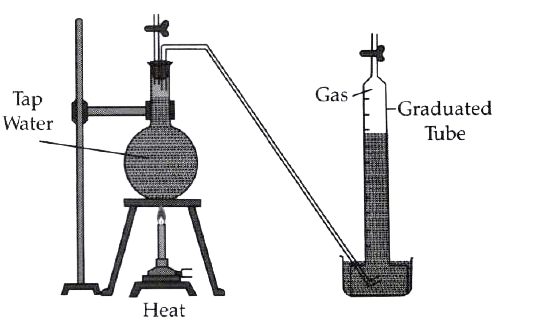Name the process of dissolving an acid or a base in water.
Exothermic reaction
Topper's Solved these Questions
Similar Questions
Answer question numbers (a) – (d) on the basis of your understanding of the following paragraph and related studied concepts.
The process of dissolving an acid or a base in water is a highly exothermic one. Care must be taken while mixing concentrated nitric acid or sulphuric acid with water. The acid must always be added slowly to water with constant stirring. If water is added to a concentrated acid, the heat generated may cause the mixture to splash out and cause burns. The glass container may also break due to excessive local heating. Look out for the warning sign on the can of concentrated sulphuric acid and on the bottle of sodium hydroxide pellets. Mixing an acid or base with water results in decrease in the concentration of ions (H3O+/OH−) per unit volume. Such a process is called dilution and the acid or the base is said to be diluted.
Tell whether heat is absorbed or evolved when an acid or base is dissolved in water
View SolutionAnswer question numbers (a) – (d) on the basis of your understanding of the following paragraph and related studied concepts.
The process of dissolving an acid or a base in water is a highly exothermic one. Care must be taken while mixing concentrated nitric acid or sulphuric acid with water. The acid must always be added slowly to water with constant stirring. If water is added to a concentrated acid, the heat generated may cause the mixture to splash out and cause burns. The glass container may also break due to excessive local heating. Look out for the warning sign on the can of concentrated sulphuric acid and on the bottle of sodium hydroxide pellets. Mixing an acid or base with water results in decrease in the concentration of ions (H3O+/OH−) per unit volume. Such a process is called dilution and the acid or the base is said to be diluted.
What is meant by dilution of an acid or a base ?
View Solution
Knowledge Check
Assertion (A): The strength of acids and bases depends on the number of H+ ions and OH− ions produced.
Reason (R) : The process of dissolving an acid or base in water is highly endothermic.ABoth (A) and (R) are true and (R) is correct explanation of the assertion.BBoth (A) and (R) are true but (R) is not the correct explanation of the assertion.C(A) is true but (R) is false.D(A) is false but (R) is true.Assertion(A): The acids must always be added slowly to water with constant stirring.
Reason (R):Dissolving an acid or a base in water in highly exothermic reaction.ABoth A and R are true, and R is the correct explanation of A.BBoth A and R are true, but R is not the correct explanation of A.CA is true but R is false.DA is false but R is true.The process of dilution of acid or base with water will result in:
ANo change in the concentration of ions (H3O+/OH−) per unit volumeBDecrease in the concentration of ions (H3O+/OH−) per unit volumeCIncrease in the concentration of ions (H3O+/OH−) Per unit volumeDDecrease in the concentrationfo H3O+ ions but increase in concentration of OH− ions per unit volume
Name the process that occurs when oxygen dissolves in water.
View SolutionThe given below experiment is to show tap water contains dissolved gases. Based on this, answer the below questions:

Name the quantity which tells you about the presence of dissolved gases in tap water from the experiment?
View SolutionIs the process of neutralisation of a strong acid by a strong base a redox process ?
View SolutionWhat is the process called in which an acid reacts with a base to produce salt and water ?
View SolutionName the process of removal of soluble mineral salts, especially the bases & silica from horizon A or the top soil by percolating rain water.
View Solution
